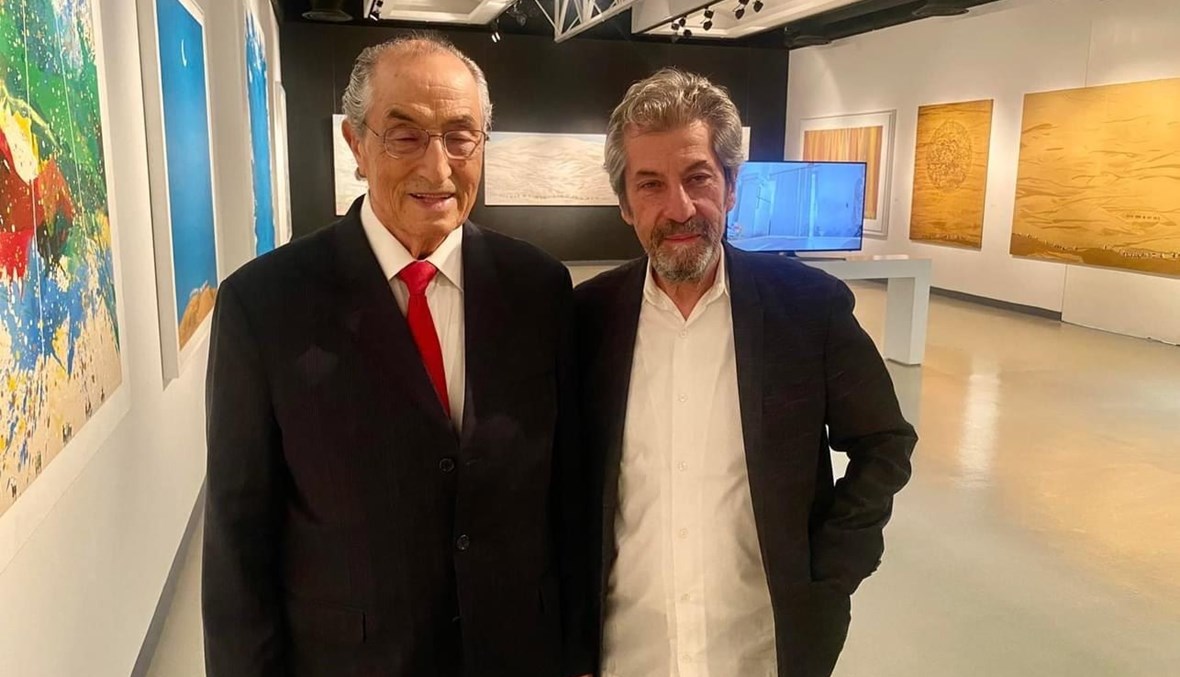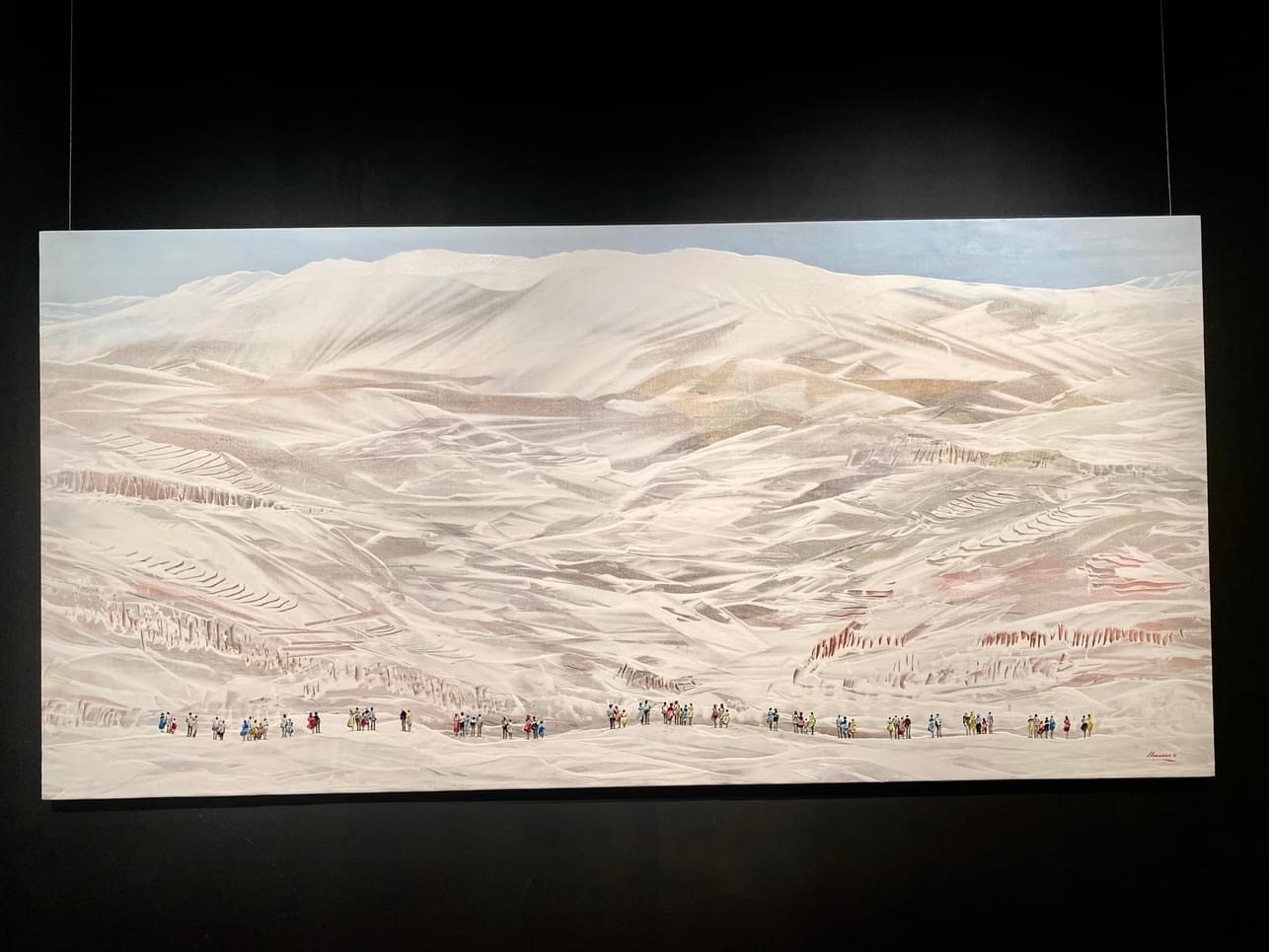The Lebanese artist Chaouki Chamoun is holding a retrospective exhibition (between October 4 - 28) of his artistic productions at the Pure Art Foundation in Riyadh, to celebrate the fiftieth anniversary of his artistic career, in cooperation with artistic director Christiane Ashkar, entitled “New Horizons”, including 69 works in various materials and techniques, including 49 wall paintings (acrylic and mixed media), as well as drawings from his early stages, reflecting in their contents and titles the various stages that the artist went through since the mid-seventies of the twentieth century, that is, the stage of studying in New York and his involvement in the art market and working there, and then his return. intermittently to Lebanon during the wars, and the artistic views that followed in the United Arab Emirates and on international platforms for contemporary art in cooperation with the Ms. Amal Traboulsi Gallery, leading to the latest productions in 2023 that were displayed at the Mark Hashem Gallery between Beirut and Paris. The exhibition is accompanied by a documentary film prepared by film director Bahij Hajeij.
Chaouki Chamoun is an oriental person who is attached to his roots and affiliation. Like all immigrants who lived in the United States of America before, he absorbed the customs of American life, especially after he delved into its thought and culture. However, this influence and absorption did not erase his orientalism, and his star in the sky remained guiding him to the land of childhood. Perhaps the artist is closest to the contemplative spirit in his surrender to colorful visions, to whose charm he responds with the bliss that art alone gives. From travel and fascination with the new world, to exhausting the forces for self-realization, he summons to his painting people as strangers, and strangers cross the human horizon, mingling with the crowds and not merging with it, as if their loneliness teaches their souls pride. Thus, Chamoun painted people as colorful shadows standing on the painting platform, as companions on his path who never left his fingers until they became his second signature.
Nature and the New York School
One of the most prominent characteristics of Chaoukii Chamoun is that he is a “giant” of nature, when he painted it in an enlarged view on wall canvases. He believed that the surface of the painting was a spiritual space conducive to all experiences, whims, contemplations, and emotions, that is, everything that pleases and amazes the eye. He stood on the riverbeds and contemplated the pebbles on the seashores. He painted women, New York’s lakes, and its parks. He also painted mighty mountains and desolate deserts. He moved to simulate contemporary imaginary buildings where the insulating walls grow thicker until they suffocate. His eyes traveled to the stars, contemplating the orbits of cosmic nature, and he also delved into the technologies responsible for creating the imaginary immensity of major cities, an inductive appreciation of technical progress, using building materials. Chamoun's building is the building of the dream of renewal in form, design and content. He presented buildings as places to live in a mosaic of night colors, in cities glowing with life. However, the artist’s relationship with reality is one of identification, as in the visible there is nothing but the debris of thought (in the words of the French philosopher Maurice Merleau-Ponty), and Shimon does not see to draw, but rather paints to see.
In the arms of nature
The “New Horizons” exhibition for art connoisseurs in the capital of the Kingdom of Saudi Arabia confirms the rich path of an artist whose early talents blossomed into painting in the embrace of nature (he was born in the village of Sarein al-Tahta in the Bekaa in 1942), where the processions of light, the majesty of the mountains, the expanse of the plains, and the endless breadth of space. If mountains are the limits of the world, does the sky have limits? Questions he asked as a child when he was running in the fields and screaming in the valleys and no one could hear him, without knowing one day that these questions would be asked of him again, and that this voice would resound in the world of art in levels and layers upon layers.
In 1968, he joined the Institute of Fine Arts at the Lebanese University, where he received the principles of drawing and painting, from his professors, who were among the elite pioneers of modern art in Lebanon (Shafik Abboud, Nadia Seikaly, Jean Khalifa, Arif Al-Rayes...).
In the sixties and early seventies, Beirut was a balcony on the world, the capital of the arts, and a home for Arab and foreign intellectuals. Chamoun continued to visit the exhibitions that were held in galleries and showrooms, and learn about modern experiences, only to find that art was moving in the direction of the arts of the Paris School, which had become exhausted, until the steps led him to the exhibition. He stayed at the Kennedy Center Gallery in Beirut in 1969, and saw works of American art for the first time. It was as if he had found his calling, realizing that he would not go to Paris like his colleagues for higher specialization, but rather the new continent would be the landing site of his dreams. In the fall of 1973, he enrolled in the College of Visual and Performing Arts at Syracuse University in New York, where he was influenced by the experiences of artists of abstract expressionism, kinetic art (action), and color field.
Carnivals of colors and desert sun
The late eighties and the beginning of the nineties marked a new phase in the life of Chaouki Chamoun, in which he recalled his childhood and the magic of his views of the Bekaa Valley, the Sarein moon, and the view of Mount Sannine in the winter, in experiences that cannot be separated from the realities of the ongoing war in Lebanon, so the theme of “waiting” appeared for the first time, and was manifested with A crowd of people stood on the painting’s platform, in a snowy scene taken from the eternal nature of Lebanon.
Because the artist dips his brush into the land of memories, he sees his figures from afar, without details, features, or shapes, but rather in small sizes, immersed in the vast, foggy expanse. Then the concept of waiting took on philosophical dimensions in the scenery of his works, and it became inherent to the routine of living in major cities, the facts of life and the conflicts and wars that surround it, especially the lost wait for peace in the land of Arab wounds.
In the summer of 1995, the “Lakes” series of paintings was born from his frequent walks by the lakes in Harriman and Tuxedo parks in New York. They appeared as color poems that reflect the manifestations of the artist’s feelings, narcissism, and flowing emotions that he seeks to put on the canvas in a repetitive system that simulates the scene as a readable reality through its color and linear texture. But Chaouki Chamoun amazed his eyes with the desert murals that emerged from a lived experience after his participation in the “Art Paris - Abu Dhabi” exhibition in the fall of 2008.
Like a traveler, he described it with its arid nature, its terrain, its sand dunes glowing under the golden rays of the sun, and its blue dome.
He painted it with the expansiveness of color for which he was known, and with the warmth of his longing to meet the land of the first ancestors, the ancient ecological cradle of man, in search of endless horizons. The desert brought to Chamoun’s eyes unprecedented images that gained international standards (between 2008-2009), with his paintings being traded at Christie’s auctions in Dubai and Sotheby’s in London, considering that the desert is not a past but a present and a future full of artistic achievements and promises that establish a new aesthetic reference. In the contemporary landscape.





